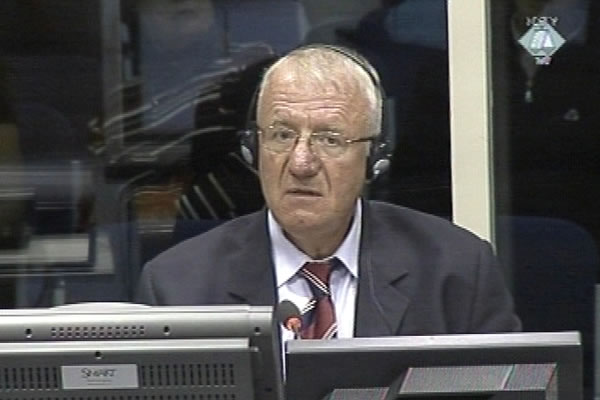Home
OVCARA ACCORDING TO SESELJ
Vojislav Seselj began his testimony in the defense of Goran Hadzic, former prime minister of the SAO Eastern Slavonia government. He blamed Aleksandar Vasiljevic and Vesna Bosanac for the massacre in Ovcara in November 1991. Vasiljevic was the JNA security chief and Vesna Bosanac was the director of the Vukovar Hospital
 Vojislav Seselj, defence witness at Goran Hadzic trial
Vojislav Seselj, defence witness at Goran Hadzic trial In a bid to refute the allegations against him, which include the killing of 194 persons at the Ovcara farm in the night of 20 November 1991, Goran Hadzic called as his witness his fellow detainee from the UN Detention Unit, Vojislav Seselj. This was Seselj’s first appearance in court after June 2013, when he testified in Radovan Karadzic’s defense. This apparently slipped Seselj’s mind, because he complained to the judges that this was his first public appearance after March 2012, when closing arguments were delivered at his trial.
In a lengthy introductory part of his testimony, Seselj spoke in detail about his education, work experience and political career. He then addressed the accusations that pertain to the joint criminal enterprise in which, as the prosecution alleges, he participated together with Hadzic. Through Seselj, the defense is trying to contest the claim that Hadzic was able to exert control over the Serb units in the field. Seselj confirmed that the Serbian Radical Party sent its volunteers to the Republic of Serbian Krajina, but their sole task was to ‘defend Serbs and not to attack Croats’. Also, Seselj confirmed that as of 1 September 1991 his volunteers were under the command of the JNA. In Eastern Slavonia his volunteers were part of the Leva Supoderica unit, under the command of Milan Lancuzanin Kameni.
Seselj then proceeded to offer his version of the Ovcara massacre. He learned about it ‘several months or a year’ after the incident, Seselj claimed. He first said that his volunteers ‘swore to him that they had not been involved in the killings’, and then he accused former chief of the JNA Security Administration Aleksandar Vasiljevic and three former JNA officers for the massacre. Vasiljevic had brought the three officers out of retirement and sent them to Vukovar, Seselj explained.
In Seselj’s version, after Vukovar was captured on 18 November 1991, the director of the Vukovar Hospital Vesna Bosanac made a list of 200 persons who were to be executed, as agreed with the Croatian authorities. As Seselj claimed, the list included mostly the poor, the lumpenproletariat and those Croats who were not enthusiastic about the new Croatian government. The next day the JNA entered the hospital. The officer in charge was Veselin Sljivancanin, the security chief in the Guards Brigade. Some of the prisoners were sent to the prison camp in Sremska Mitrovica, and 207 prisoners were sent first to the Vukovar military barracks and then to the Ovcara farm. Seven men were released at Ovcara, and the others were executed. The JNA personnel dug the grave, Vasiljevic’s security officers supervised the entire process, and the JNA then did everything it could to cover up the crime. A total of 200 bodies were exhumed from the grave. Seven of them were not identified because they were Kurds and there was nobody to claim them, Seselj said.
The cross-examination started as the hearing drew to a close. Prosecutor Lisa Biersay tried to establish why Seselj never asked Dr. Bosanac about her agreement with the Croatian authorities when she testified in his case. Seselj insisted that ‘as a matter of principle’ he refused to cross-examine witnesses whose evidence was based on previous statements or testimonies. Seselj will continue his testimony tomorrow.
Linked Reports
- Case : Hadzic
- 2014-09-08 KUDOS TO ACCUSED
- 2014-09-05 HADZIC WAS ‘BRAVE’, BABIC WAS ‘HEADSTRONG’ AS THE LOG REVOLUTION UNFOLDED
- 2014-09-03 CONFLICT IN CROATIA THROUGH EYES OF BRITON
- 2014-09-10 DID SESELJ ‘REVISE’ OR ‘SUPPLEMENT’ HIS TESTIMONY?
- 2014-09-11 CULTURE MINISTER TESTIFIES IN PRIME MINISTER’S DEFENSE
- 2014-09-16 WHAT ‘LIES’ WERE SPREAD ABOUT WITNESS
